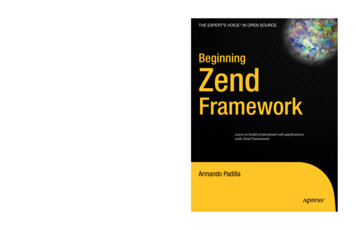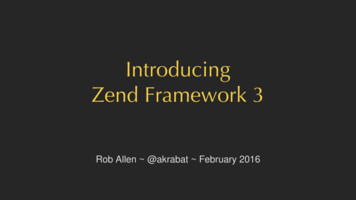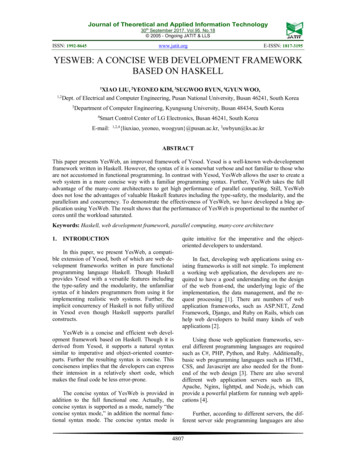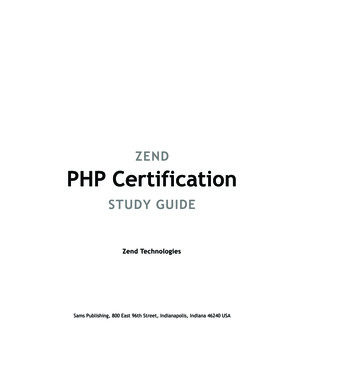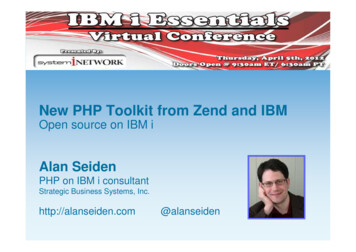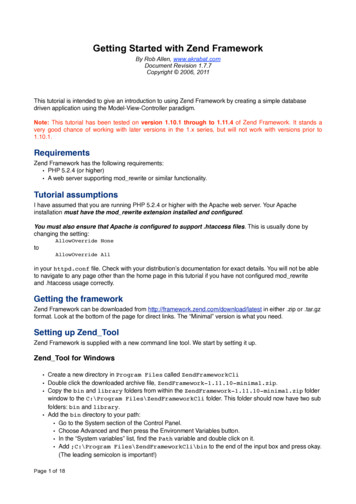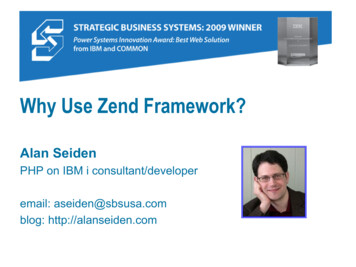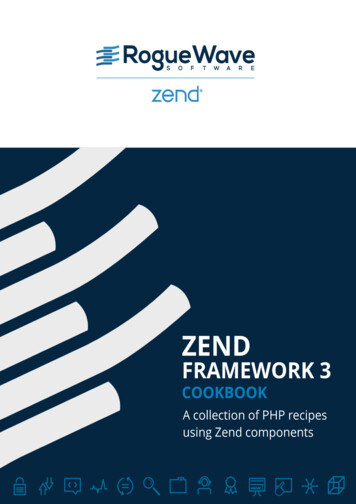
Transcription
Table of ContentsIntroduction1.1About the authors1.2Configurationzend-config for all your configuration needs2.1Manage your application with zend-config-aggregator2.2Data ManipulationConvert objects to arrays and back with zend-hydrator3.1Scrape Screens with zend-dom3.2Paginating data collections with zend-paginator3.3Log and FeedsLogging PHP applications4.1Discover and Read RSS and Atom Feeds4.2Create RSS and Atom Feeds4.3Authentication and AuthorizationManage permissions with zend-permissions-rbac5.1Manage permissions with zend-permissions-acl5.2Web ServicesImplement JSON-RPC with zend-json-server6.1Implement an XML-RPC server with zend-xmlrpc6.2Implement a SOAP server with zend-soap6.32
SecurityContext-specific escaping with zend-escaper7.1Filter input using zend-filter7.2Validate input using zend-validator7.3Validate data using zend-inputfilter7.4End-to-end encryption with Zend Framework 37.5Deployment and VirtualizationCreate ZPKs the Easy Way8.1Using Laravel Homestead with Zend Framework Projects8.2CopyrightCopyright note9.13
IntroductionZend Framework 3 CookbookDuring the year 2017, Matthew Weier O'Phinney and Enrico Zimuel started a series of blogposts on the offical Zend Framework blog covering its components.Zend Framework is composed by 60 components covering a wide range of functionality.While the framework has typically been marketed as a full-stack MVC framework, theindividual components themselves typically work independently and can be used standaloneor within other frameworks. The blog posts were written to highlight this fact, anddemonstrate how to get started with a number of the more popular and useful components.We hope this book will help you get started using Zend Framework components, no matterwhat project you are writing!Enjoy your reading,Matthew Weier O'Phinney and Enrico ZimuelRogue Wave Software, Inc.4
About the authorsAbout the authorsMatthew Weier O'Phinney is a Principal Engineer at Rogue Wave Software, and projectlead for the Zend Framework, Apigility, and Expressive projects. He’s responsible forarchitecture, planning, and community engagement for each project, which are used bythousands of developers worldwide, and shipped in projects from personal websites tomultinational media conglomerates, and everything in between. When not in front of acomputer, you'll find him with his family and dogs on the plains of South Dakota.For more .com/Enrico Zimuel has been a software developer since 1996. He works as a Senior SoftwareEngineer at Rogue Wave Software as a core developer of the Zend Framework, Apigility,and Expressive projects. He is a former Researcher Programmer for the Informatics Instituteof the University of Amsterdam. Enrico speaks regularly at conferences and events,including TEDx and international PHP conferences. He is also the co-founder of the PHPUser Group of Torino (Italy).For more information:https://www.zimuel.it/5
About the authorshttps://www.roguewave.com/TEDx presentation: https://www.youtube.com/watch?v SienrLY40-wPHP User Group of Torino: http://torino.grusp.org/6
zend-config for all your configuration needsZend-config for all your configurationneedsby Matthew Weier O'PhinneyDifferent applications and frameworks have different opinions about how configurationshould be created. Some prefer XML, others YAML, some like JSON, others like INI, andsome even stick to the JavaProperties format; in Zend Framework, we tend to prefer PHParrays, as each of the other formats essentially get compiled to PHP arrays eventuallyanyways.At heart, though, we like to support developer needs, whatever they may be, and, as such,our zend-config component1 provides ways of working with a variety of configurationformats.Installationzend-config is installable via Composer: composer require zendframework/zend-configThe component has two dependencies:zend-stdlib2, which provides some capabilities around configuration merging.psr/container3, to allow reader and writer plugin support for the configuration factory.Latest versionThis article covers the most recently released version of zend-config, 3.1.0, whichcontains a number of features such as PSR-11 support that were not previouslyavailable. If you are using Zend Framework MVC layer, you should be able to safelyprovide the constraint 2.6 3.1, as the primary APIs remain the same.Retrieving configurationOnce you've installed zend-config, you can start using it to retrieve and access configurationfiles. The simplest way is to useZend\Config\Factory, which provides tools for loadingconfiguration from a variety of formats, as well as capabilities for merging.7
zend-config for all your configuration needsIf you're just pulling in a single file, useFactory::fromFile():use Zend\Config\Factory; config Factory::fromFile( path);Far more interesting is to use multiple files, which you can do viaFactory::fromFiles().When you do, they are merged into a single configuration, in the order in which they areprovided to the factory. This is particularly interesting usingglob():use Zend\Config\Factory; config is method supports a variety of formats:PHP files returning arrays (INI files (extension).iniJSON files (extension).php.jsonextension)XML files (using PHP'sXMLReader;.xmlextension)YAML files (using ext/yaml, installable via PECL;JavaProperties files (.yamlextension)extension).javapropertiesThis means that you can choose the configuration format you prefer, or mix-and-matchmultiple formats, if you need to combine configuration from multiple libraries!Configuration objectsBy default,Zend\Config\Factorywill return PHP arrays for the merged configuration. Somedependency injection containers do not support arrays as services, however; moreover, youmay want to pass some sort of structured object instead of a plain array when injectingdependencies.As such, you can pass a second, optional argument to each offromFiles(), a boolean flag. Whenwhich implementsCountable,trueIterator, it will return a, nce,, allowing it to look and act likean array.What is the benefit?First, it provides property overloading to each configuration key:8
zend-config for all your configuration needs debug config- debug ? false;Second, it offers a convenience method,get(), which allows you to specify a default valueto return if the value is not found: debug config- get('debug', false); // Return false if not foundThis is largely obviated by the?ternary shortcut in modern PHP versions, but very usefulwhen mocking in your tests.Third, nested sets are also returned asthe aboveget()Configinstances, which gives you the ability to usemethod on a nested item:if (isset( config- expressive)) { config config- get('expressive'); // same API!}Fourth, you can mark theConfiginstance as immutable! By default, it acts just like arrayconfiguration, which is, of course, mutable. However, this can be problematic when you useconfiguration as a service, because, unlike an array, aConfiginstance is passed byreference, and changes to values would then propagate to any other services that dependon the configuration.Ideally, you wouldn't be changing any values in the instance, butZend\Config\Configcanenforce that for you: config- setReadOnly(); // Now immutable!Further, calling this will mark nestedConfiginstances as read-only as well, ensuring dataintegrity for the entire configuration tree.9
zend-config for all your configuration needsRead-only by default!One thing to note: by default,instances are read-only! The constructor acceptsConfigan optional, second argument, a flag indicating whether or not the instance allowsmodifications, and the value isaConfigby default. When you use thefalseFactoryinstance, it never enables that flag, meaning that if you return ato createConfiginstance, it will be read-only.If you want a mutable instance from aFactory, use the following construct:use Zend\Config\Config;use Zend\Config\Factory; config new Config(Factory::fromFiles( files), true);Including other configurationMost of the configuration reader plugins also support "includes": directives within aconfiguration file that will include configuration from another file. (JavaProperties is the onlyconfiguration format we support that does not have this functionality included.)For instance:INI files can use the key@includeto include another file relative to the current one;values are merged at the same level:webhost 'www.example.com'@include 'database.ini'For XML files, you can use XInclude: ?xml version "1.0" encoding "utf-8" config xmlns:xi "http://www.w3.org/2001/XInclude" webhost www.example.com /webhost xi:include href "database.xml"/ /config JSON files can use an@includekey:{"webhost": "www.example.com","@include": "database.json"}10
zend-config for all your configuration needsYAML also uses the@includenotation:webhost: www.example.com@include: database.yamlChoose your own YAMLOut-of-the-box we support the YAML PECL extension for our YAML support. However, wehave made it possible to use alternate parsers, such as Spyc or the Symfony YAMLcomponent, by passing a callback to the reader's constructor:use Symfony\Component\Yaml\Yaml as SymfonyYaml;use Zend\Config\Reader\Yaml as YamlConfig; reader new YamlConfig([SymfonfyYaml::class, 'parse']); config reader- fromFile('config.yaml');Of course, if you're going to do that, you could just use the original library, right? But what ifyou want to mix YAML and other configuration with theFactoryclass?There are two ways to register new plugins. One is to create an instance and register it withthe factory:use Symfony\Component\Yaml\Yaml as SymfonyYaml;use Zend\Config\Factory;use Zend\Config\Reader\Yaml as YamlConfig;Factory::registerReader('yaml', new YamlConfig([SymfonyYaml::class, 'parse']));Alternately, you can provide an alternate reader plugin manager. You can do that er, which is a barebones PSR-11container for use as a plugin manager:11
zend-config for all your configuration needsnamespace Acme;use Symfony\Component\Yaml\Yaml as SymfonyYaml;use Zend\Config\Reader\Yaml as YamlConfig;use Zend\Config\StandaloneReaderPluginManager;class ReaderPluginManager extends StandaloneReaderPluginManager{/*** @inheritDoc*/public function has( plugin){if (YamlConfig::class plugin 'yaml' strtolower( plugin)) {return true;}return parent::has( plugin);}/*** @inheritDoc*/public function get( plugin){if (YamlConfig::class ! plugin&& 'yaml' ! strtolower( plugin)) {return parent::get( plugin);}return new YamlConfig([SymfonyYaml::class, 'parse']);}}Then register this with theFactory:use Acme\ReaderPluginManager;use r(new ReaderPluginManager());Processing configurationzend-config also allows you to process aZend\Config\Configinstance and/or an individualvalue. Processors perform operations such as:12
zend-config for all your configuration needssubstituting constant values within stringsfiltering configuration datareplacing tokens within configurationtranslating configuration valuesWhy would you want to do any of these operations?Consider this: deserialization of formats other than PHP cannot take into account PHPconstant values or class names!While this may work in PHP:return [Acme\Component::CONFIG KEY ['host' Acme\Component::CONFIG HOST,'dependencies' ['factories' [Acme\Middleware\Authorization::class ];The following JSON configuration would not:{"Acme\\Component::CONFIG KEY": {"host": "Acme\\Component::CONFIG HOST""dependencies": {"factories": {"Acme\\Middleware\\Authorization::class": }Enter theConstantprocessor!This processor looks for strings that match constant names, and replaces them with theirvalues. Processors generally only work on the configuration values, but theConstantprocessor allows you to opt-in to processing the keys as well.Since processing modifies theConfiginstance, you will need to manually create aninstance, and then process it. Let's look at that:13
zend-config for all your configuration needsuse Acme\Component;use Zend\Config\Config;use Zend\Config\Factory;use Zend\Config\Processor; config new Config(Factory::fromFile('config.json'), true); processor new Processor\Constant(); processor- enableKeyProcessing(); processor- process( config); config- setReadOnly();var export( config- {Component::CONFIG KEY}- dependencies- factories);// ['Acme\Middleware\Authorization' 'Acme\Middleware\AuthorizationFactory']This is a really powerful feature, as it allows you to add more verifications and validations toyour configuration files, regardless of the format you use.In version 3.1.0 forwardThe ability to work with class constants and process keys was added starting with the3.1.0 version of zend-config.Config all the things!This post covers the parsing features of zend-config, but does not even touch on anothermajor capability: the ability to write configuration! We'll leave that to another post.In terms of configuration parsing, zend-config is simple, yet powerful. The ability to process anumber of common configuration formats, utilize configuration includes, and process keysand values means you can highly customize your configuration process to suit your needs orintegrate different configuration sources.Get more information from the zend-config documentation4.Footnotes1. https://docs.zendframework.com/zend-config/ 2. https://docs.zendframework.com/zend-stdlib/ 3. https://github.com/php-fig/container 4. https://docs.zendframework.com/zend-config/ 14
zend-config for all your configuration needs15
Manage your application with zend-config-aggregatorManage your application with zend-configaggregatorby Matthew Weier O'PhinneyWith the rise of PHP middleware, many developers are creating custom applicationarchitectures, and running into an issue many frameworks already solve: how to allowruntime configuration of the application.configuration is often necessary, even in custom applications:Some configuration, such as API keys, may vary between environments.You may want to substitute services between development and production.Some code may be developed by other teams, and pulled into your application1separately (perhaps via Composer ), and require configuration.You may be writing code in your application that you will later want to share with anotherteam, and recognize it should provide service wiring information or allow for dynamicconfiguration itself.Faced with this reality, you then have a new problem: how can you configure yourapplication, as well as aggregate configuration from other sources?As part of the Expressive initiative, we now offer a standalone solution for you: zend-config2aggregator .InstallationFirst, you will need to install zend-config-aggregator: composer require zendframework/zend-config-aggregatorOne feature of zend-config-aggregator is the ability to consume multiple configurationformats via zend-config3. If you wish to use that feature, you will also need to install thatpackage: composer require zendframework/zend-configFinally, if you are using the above, and want to parse YAML files, you will need to install theYAML PECL extension4.16
Manage your application with zend-config-aggregatorConfiguration providerszend-config-aggregator allows you to aggregate configuration from configuration providers.A configuration provider is any PHP callable that will return an associative array ofconfiguration.By default, the component provides the following providers out of the box:Zend\ConfigAggregator\ArrayProvider, which accepts an array of configuration andsimply returns it. This is primarily useful for providing global defaults for your application.Zend\ConfigAggregator\PhpFileProvider, which accepts a glob pattern describing PHPfiles that each return an associative array. When invoked, it will loop through each file,and merge the results with what it has previously FileProvider, which acts similarly to the, but which can aggregate any format zend-config supports, includingINI, XML, JSON, and YAML.More interestingly, however, is the fact that you can write providers as simple invokableobjects:namespace Acme;class ConfigProvider{public function invoke(){return [// associative array of configuration];}}This feature allows you to write configuration for specific application features, and then seedyour application with it. In other words, this feature can be used as the foundation for amodular architecture5, which is exactly what we did with Expressive!17
Manage your application with zend-config-aggregatorGeneratorsYou may also use invokable classes or PHP callables that define generators asconfiguration providers! As an example, thePhpFileProvidercould potentially berewritten as follows:use Zend\Stdlib\Glob;function () {foreach (Glob::glob('config/*.php', Glob::GLOB BRACE) as file) {yield include file;}}Aggregating configurationNow that you have configuration providers, you can aggregate them.For the purposes of this example, we'll assume the following:We will have a single configuration file,config.php, at the root of our application whichwill aggregate all other configuration.We have a number of configuration files underconfig/, including YAML, JSON, andPHP files.We have a third-party "module" that exposes the classUmbrella\ConfigProvider.We have developed our own "module" for re-distribution that exposes the classBlanket\ConfigProvider.Typically, you will want aggregate configuration such that third-party configuration is loadedfirst, with application-specific configuration merged last, in order to override settings.Let's aggregate and return our configuration.// in config.php:use Zend\ConfigAggregator\ConfigAggregator;use Zend\ConfigAggregator\ZendConfigProvider; aggregator new \Blanket\ConfigProvider::class,new return aggregator- getMergedConfig();18
Manage your application with zend-config-aggregatorThis file aggregates the third-party configuration provider, the one we expose in our ownapplication, and then aggregates a variety of different configuration files in order to, in theend, return an associative array representing the merged configuration!Valid config profider entriesYou'll note that theConfigAggregatorexpects an array of providers as the firstargument to the constructor. This array may consist of any of the following:Any PHP callable (functions, invokable objects, closures, etc.) returning an array.A class name of a class that definesinvoke(), and which requires noconstructor arguments.This latter is useful, as it helps reduce operational overhead once you introducecaching, which we discuss below. The above example demonstrates this usage.zend-config and PHP configurationThe above example uses only theZendConfigProvider, and not thePhpFileProvider.This is due to the fact that zend-config can also consume PHP configuration.If you are only using PHP-based configuration files, you can use thePhpFileProviderinstead, as it does not require additionally installing the zendframework/zend-configpackage.Globbing and precedenceGlobbing works as it does on most *nix systems. As such, you need to pay particularattention to when you use patterns that define alternatives, such as the{json,yaml,php}pattern above. In such cases, all JSON files will be aggregated,followed by YAML files, and finally PHP files. If you need them to aggregate in adifferent order, you will need to change the pattern.CachingYou likely do not want to aggregate configuration on each and every application request,particularly if doing so would result in many filesystem hits. Fortunately, zend-configaggregator also has built-in caching features.To enable these features, you will need to do two things:First, you need to provide a second argument to theConfigAggregatorconstructor,19
Manage your application with zend-config-aggregatorspecifying the path to the cache file to create and/or use.Second, you need to enable caching in your configuration, by specifying a booleantruevalue for the keyConfigAggregator::ENABLE CACHE.One common strategy is to enable caching by default, and then disable it via environmentspecific configuration.We'll update the above example now to enable caching to the filecache/config.php:use Zend\ConfigAggregator\ArrayProvider;use Zend\ConfigAggregator\ConfigAggregator;use Zend\ConfigAggregator\PhpFileProvider;use Zend\ConfigAggregator\ZendConfigProvider; aggregator new ConfigAggregator([new ArrayProvider([ConfigAggregator::ENABLE CACHE nfigProvider::class,new php}'),new config.php');return aggregator- getMergedConfig();The above adds an initial setting that enables the cache, and tells it to cache it tocache/config.php.Notice also that this example changes thePhpFileProviderTheZendConfigProvider, and adds aentry. Let's examine these.ZendConfigProviderglob pattern now looks for files namedaccepted extensions, or those named*.globalglobalwith one of thewith one of the accepted extensions. Thisallows us to segregate configuration that should always be present from environmentspecific configuration.We then add aPhpFileProviderthat lly. An interesting side-note about the shipped providers is that if no matching filesare found, the provider will return an empty array; this means that we can have thisadditional provider that is looking for separate configurations for the "local" environment!Because this provider is aggregated last, the settings it exposes will override any others.As such, if we want to disable caching, we can create a file such asconfig/local.phpwiththe following contents:20
Manage your application with zend-config-aggregator ?phpuse Zend\ConfigAggregator\ConfigAggregator;return [ConfigAggregator::ENABLE CACHE false];and the application will no longer cache aggregated configuration!Clear the cache!The setting outlined above is used to determine whether the configuration cache fileshould be created if it does not already exist. zend-config-aggregator, when providedthe location of a configuration cache file, will load directly from it if the file is present.As such, if you make the above configuration change, you will first need to remove anycached configuration: rm cache/config.phpThis can even be made into a Composer script:"scripts": {"clear-config-cache": "rm cache/config.php"}Allowing you to do this: composer clear-config-cacheWhich allows you to change the location of the cache file without needing to re-learnthe location every time you need to clear the cache.Auto-enabling third-party providersBeing able to aggregate providers from third-parties is pretty stellar; it means that you canbe assured that configuration the third-party code expects is generally present — with theexception of values that must be provided by the consumer, that is!However, there's one minor problem: you need to remember to register these configurationproviders with your application, by manually editing yourconfig.phpfile and adding theappropriate entries.621
Manage your application with zend-config-aggregator6Zend Framework solves this via the zf-component-installer Composer plugin . If yourpackage is installable via Composer, you can add an entry to your package definition asfollows:"extra": {"zf": {"config-provider": ["Umbrella\\ConfigProvider"]}}If the end-user:Has requiredzendframework/zend-component-installerin their application (as either aproduction or development dependency), ANDhas the config aggregation script inconfig/config.phpthen the plugin will prompt you, asking if you would like to add each of theconfig-providerentries found in the installed package into the configuration script.As such, for our example to work, we would need to move our configuration script toconfig/config.php, and likely move our other configuration files into a .jsonThis approach is essentially that taken by Expressive.When those changes are made, any package you add to your application that exposesconfiguration providers will prompt you to add them to your configuration aggregation, and, ifyou confirm, will add them to the top of the script!Final notesFirst, we would like to thank Mateusz Tymek7, whose prototype 'expressive-config-manager'project became zend-config-aggregator. This is a stellar example of a community projectgetting adopted into the framework!22
Manage your application with zend-config-aggregatorSecond, this approach has some affinity to a proposal from the folks who brought us PSR11, which defines theContainerInterfaceused within Expressive for allowing usage ofdifferent dependency injection containers. That same group is now working on a serviceprovider8 proposal that would standardize how standalone libraries expose services tocontainers; we recommend looking at that project as well.We hope that this post helps spawn ideas for configuring your next project!Footnotes1. https://getcomposer.org 2. gator 3. https://docs.zendframework.com/zend-config/ 4. http://www.php.net/manual/en/book.yaml.php 5. tures/modular-applications/ 6. aller/ 7. http://mateusztymek.pl/ 8. der 23
Convert objects to arrays and back with zend-hydratorConvert objects to arrays and back withzend-hydratorby Matthew Weier O'PhinneyAPIs are all the rage these days, and a tremendous number of them are being written inPHP. When APIs were first gaining popularity, this seemed like a match made in heaven:query the database, pass the results toit'sjson decode()json encode(), and voilà! API payload! In reverse,, pass the data to the database, and done!Modern day professional PHP, however, is skewing towards usage of value objects andentities, but we're still creating APIs. How can we take these objects and create our APIresponse payloads? How can we take incoming data and transform it into the domainobjects we need?Zend Framework's answer to that question is zend-hydrator. Hydrators can extract anassociative array of data from an object, and hydrate an object from an associative array ofdata.InstallationAs with our other components, you can install zend-hydrator by itself: composer require zendframework/zend-hydratorOut-of-the-box, it only requires zend-stdlib, which is used internally for transforming iteratorsto associative arrays. However, there are a number of other interesting, if optional, featuresthat require other components:You can create an aggregate hydrator where each hydrator is responsible for a subsetof data. This requires zend-eventmanager.You can filter/normalize the keys/properties of data using naming strategies; theserequire zend-filter.You can map object types to hydrators, and delegate hydration of arbitrary objects usingtheDelegatingHydrator. This feature utilizes the providedHydratorPluginManager,which requires zend-servicemanager.In our examples below, we'll be demonstrating naming strategies and the delegatinghydrator, so we will install the dependencies those need:24
Convert objects to arrays and back with zend-hydrator composer require zendframework/zend-filter zendframework/zend-servicemanagerObjects to arrays and back againLet's take the following class definition:namespace Acme;class Book{private id;private title;private author;public function construct(int id, string title, string author){ this- id id; this- title title; this- author author;}}What we have is a value object, with no way to publicly grab any given datum. We now wantto represent it in our API. How do we do that?The answer is via reflection, and zend-hydrator provides a solution for that:use Acme\Book;use Zend\Hydrator\Reflection as ReflectionHydrator; book new Book(42, 'Hitchhiker\'s Guide to the Galaxy', 'Douglas Adams'); hydrator new ReflectionHydrator(); data hydrator- extract( book);We now have an array representation of ourBookinstance!Let's say that somebody has just submitted a book via a web form or an API. We have thevalues, but want to create aBookout of them.25
Convert objects to arrays and back with zend-hydratoruse Acme\Book;use ReflectionClass;use Zend\Hydrator\Reflection as ReflectionHydrator; hydrator new ReflectionHydrator(); book hydrator- hydrate( incomingData,(new ReflectionClass(Book::class))- newInstanceWithoutConstructor());And now we have nstruct is necessary in this case because ourclass has required constructor arguments. Another possibility is to provide an alreadypopulated instance, and hope that the submitted data will overwrite all data in the class.Alternately, you can create classes that have optional constructor arguments.Most of the time, it can be as simple as this: create an appropriate hydrator instance, anduse eitherextract()to get an array representation of the object, orhydrate()to create aninstance from an array of data.We provide a number of standard ks withhydrate any object implementing either the methodand extract from any object implementingZend\Hydrator\ClassMethodsobjects. It also (),.will use setter and getter m
Zend Framework 3 Cookbook During the year 2017, Matthew Weier O'Phinney and Enrico Zimuel started a series of blog posts on the offical Zend Framework blog covering its components. Zend Framework is composed by 60 components covering a wide range of functionality. While the framework has typically been marketed as a full-stack MVC framework, the
